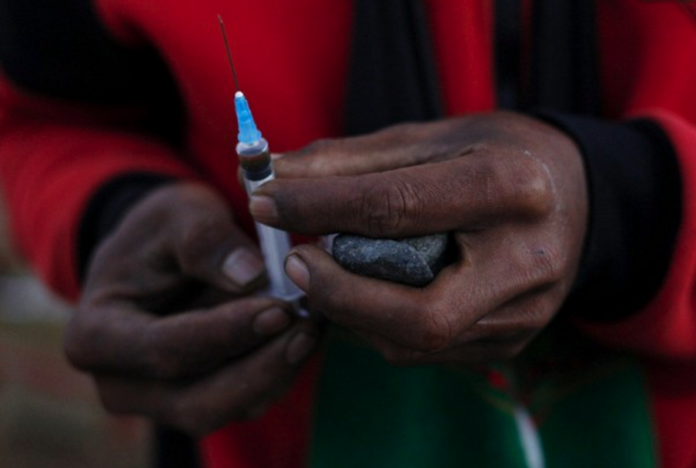
The original numbers were startling enough – 30 heroin overdoses across Cincinnati in a single weekend.
Then they just kept climbing.
Another 78 overdoses and at least three deaths were reported during a 48-hour period Tuesday and Wednesday.
And at the end of last week, after a six-day stretch of emergency room visits that exhausted first responders and their medical supplies, the overdose tally soared to a number health officials are calling “unprecedented”: 174.
On average, Cincinnati sees four overdose reports per day, the Cincinnati Enquirer reported, and usually no more than 20 or 25 in a given week.
But pure heroin is what’s responsible for that average. And that’s not what’s on the streets now, they say. The culprit responsible for the staggering number of 174 was likely heroin cut with the latest opioid boost meant to deliver consumers a stronger, extended high – carfentanil. That’s a tranquilizer for, among other large animals, elephants. And it’s 100,000 stronger than morphine.
For now, law enforcement officials have been unable to track down the source of the toxic cocktail, but believe the spate of record-high overdoses could be caused by a single heroin batch laced with carfentanil.
State, local and federal authorities have mobilized across Hamilton County – home to Cincinnati – to investigate the source or sources, Newtown Police Chief Tom Synan told the Enquirer.
Synan also heads the law enforcement task force for the Hamilton County Heroin Coalition, which was created so public health and law enforcement officials from Ohio, Indiana and Kentucky could collaboratively combat the heroin epidemic plaguing the tri-state area.
Additional heroin overdoses reported in that area, plus New Jersey, tipped the total to 225-plus, according to reporting on Fox 13 News Now.
In the same time period of the Cincinnati overdoses, 13 were reported in Jennings County, Ind., last Tuesday, 12 were reported on Wednesday in Montgomery County, Kentucky, and 29 overdoses linked to free samples of heroin, marked with a Batman symbol, were reported between Tuesday and Thursday in Camden, New Jersey.
That comes after 27 people overdosed during a five hour period on Aug. 15 in one town in West Virginia.
But the epidemic surrounding Cincinnati has captured the most national attention – and area leaders are not sugar coating the situation.
“It’s unlike anything we’ve seen before,” Hamilton County Commissioner Dennis Deters told the Enquirer.
He called the startling uptick a public health emergency.
“This is unprecedented to see as many alerts as we’ve seen in the last six days,” the county’s health commissioner, Tim Ingram, told the Enquirer Friday.
Officials have even begged people to turn away from the drug while the source of this potent batch is still a mystery.
“We’re urging you, please don’t do heroin right now,” Synan said, according to WCPO Cincinnati. “If for no other reason, because we don’t know what’s in the stuff on the street.”
Carfentanil, a cousin of the less potent but still dangerous opioid fentanyl, is the strongest commercially-used opioid. As they continue to do with fentanyl, drug dealers have begun cutting their heroin supplies with carfentanil to make it stretch for longer periods of time and deliver stronger – and more addictive – highs.
“These people are intentionally putting in drugs they know can kill someone,” Synan told WCPO. “The benefit for them is if the user survives it is such a powerful high for them, they tend to come back . . . If one or two people die, they could care less. They know the supply is so big right now that if you lose some customers in their eyes there’s always more in line.”
Further complicating matters is that Narcan, the nasal-spray version of the drug Naxalone, which reverses the side effects of an overdose, isn’t working anymore, at least not as reliably. Usually one, maybe two doses of Narcan will stabilize a patient. But the recent overdoses required two or three times that dosage.
Tests to determine if the heroin contained fentanyl or carfentanil aren’t yet available at most hospitals in the city, the Enquirer reported.
“We can’t confirm in the short term if someone’s had fentanyl, carfentanil or heroin – the tests flag only as positive or negative for opiates,” Nanette Bentley, spokeswoman for Mercy Health, told the newspaper.
Ultimately, this past week’s outbreak has been most taxing on the first responders.
“It’s been exhausting,” Cincinnati Police Lt. Col. Mike John told the Enquirer. “They’re running from one run to another. It’s been very taxing on the officers and the fire department.”
Picture: Reuters
—
(c) 2016, The Washington Post · Katie Mettler

